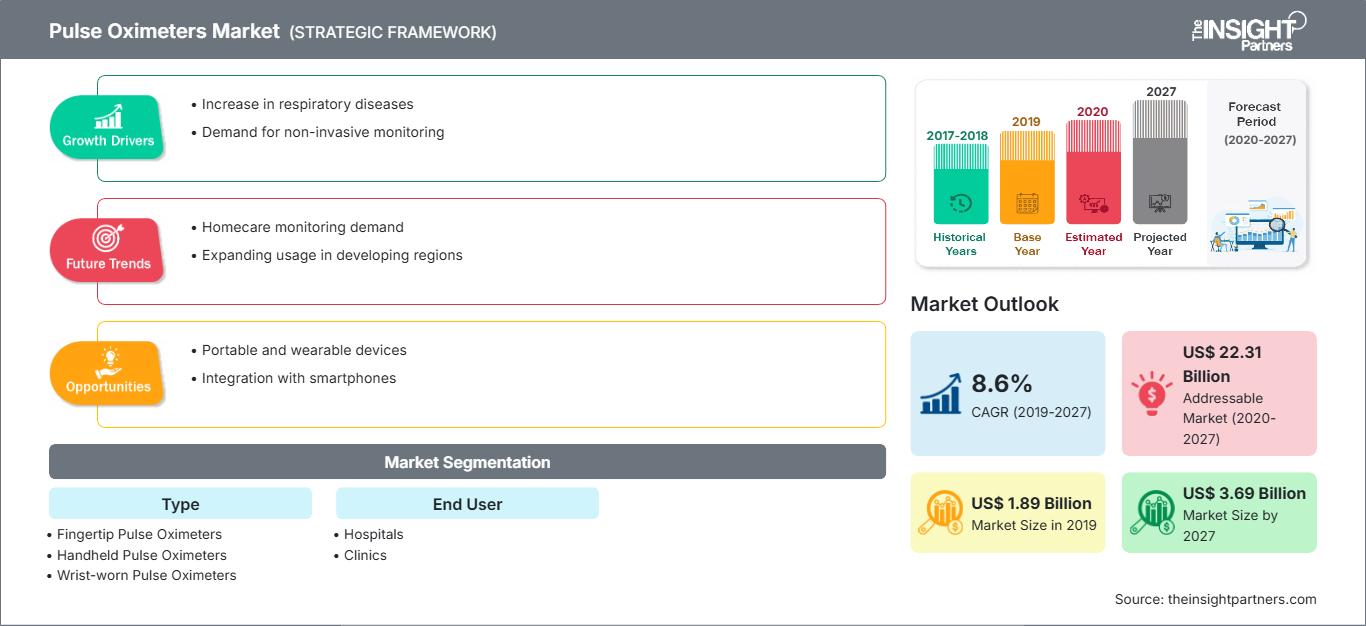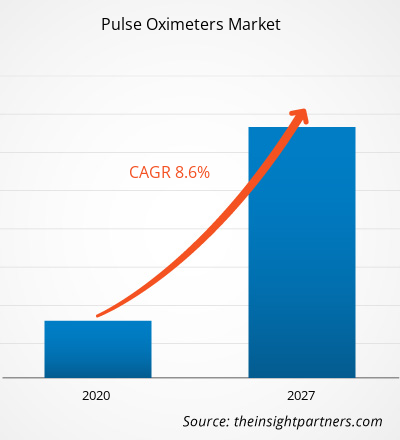Le marché des oxymètres de pouls était évalué à 1 892 millions de dollars américains en 2019 et devrait atteindre 3 693,92 millions de dollars américains d'ici 2027 ; il devrait croître à un TCAC de 8,6 % entre 2020 et 2027.
L'oxymètre de pouls est un appareil non invasif utilisé pour surveiller le niveau de saturation en oxygène dans le sang. Il s'agit d'un petit dispositif en forme de pince qui se fixe au doigt ou au lobe de l'oreille. Il est principalement utilisé en soins intensifs, en bloc opératoire, en soins d'urgence et chez les patients en haute altitude pour évaluer l'oxygénation du patient afin de déterminer s'il a besoin d'oxygène supplémentaire. De plus, le marché des oxymètres de pouls est utile pour les patients souffrant de problèmes cardiaques, de problèmes respiratoires et de bronchopneumopathies chroniques obstructives.
Aperçu du marché : La prévalence croissante des maladies respiratoires stimule la croissance du marché
La prévalence croissante des maladies respiratoires est liée à la diminution de la taille de la lumière des voies aériennes supérieures avec l'âge. Un pourcentage important de la population mondiale souffre de divers types de maladies respiratoires. Le tabagisme, les facteurs génétiques et les infections comptent parmi les facteurs courants à l'origine des maladies respiratoires. La bronchopneumopathie chronique obstructive (BPCO), l'apnée du sommeil, l'arythmie cardiaque, les affections ischémiques, le diabète, l'hypertension et l'asthme comptent parmi les pathologies qui pèsent lourdement sur le système de santé publique de divers pays. Selon l'American Lung Association, la BPCO est la troisième cause de décès aux États-Unis, où plus de 16,4 millions de personnes sont diagnostiquées avec cette maladie. De plus, selon le ministère américain de la Santé et des Services sociaux, environ 25 millions de personnes aux États-Unis souffraient d'asthme en 2019, l'une des maladies respiratoires les plus courantes au monde. Les patients souffrant de ces troubles respiratoires éprouvent généralement des difficultés respiratoires et un manque d'oxygène. L'oxymètre de pouls offre une méthode non invasive et sûre pour mesurer la saturation en oxygène.
L'augmentation du nombre de cas de COVID-19 dans le monde stimule également la demande d'oxymètres de pouls. La surveillance continue des paramètres respiratoires est l'une des principales étapes du traitement des patients atteints de COVID-19. Par conséquent, pour une prise en charge et un traitement précis des cas de COVID-19, les professionnels de santé ont besoin d'oxymètres de pouls et d'autres moniteurs multiparamétriques. De plus, différents types d'oxymètres de pouls sont largement utilisés pour la surveillance de routine à domicile.
Personnalisez ce rapport en fonction de vos besoins
Vous bénéficierez d’une personnalisation sur n’importe quel rapport - gratuitement - y compris des parties de ce rapport, ou une analyse au niveau du pays, un pack de données Excel, ainsi que de profiter d’offres exceptionnelles et de réductions pour les start-ups et les universités
Marché des oxymètres de pouls: Perspectives stratégiques

- Obtenez les principales tendances clés du marché de ce rapport.Cet échantillon GRATUIT comprendra une analyse de données, allant des tendances du marché aux estimations et prévisions.
Aperçu des produits
Vous bénéficierez d’une personnalisation sur n’importe quel rapport - gratuitement - y compris des parties de ce rapport, ou une analyse au niveau du pays, un pack de données Excel, ainsi que de profiter d’offres exceptionnelles et de réductions pour les start-ups et les universités
Marché des oxymètres de pouls: Perspectives stratégiques

- Obtenez les principales tendances clés du marché de ce rapport.Cet échantillon GRATUIT comprendra une analyse de données, allant des tendances du marché aux estimations et prévisions.
En termes de type, le segment des oxymètres de pouls digitaux détenait la plus grande part du marché des oxymètres de pouls en 2019 et devrait maintenir sa domination et enregistrer un TCAC plus élevé sur le marché au cours de la période de prévision.
Aperçu des types de capteurs
En fonction du type de capteur, le marché mondial des oxymètres de pouls est segmenté en réutilisables et jetables. Le segment réutilisable détenait la plus grande part du marché en 2019 et devrait enregistrer le TCAC le plus élevé au cours de la période de prévision. Cette croissance peut être attribuée à l'augmentation du nombre de patients atteints de la COVID-19 dans le monde.
Aperçu des utilisateurs finaux
En fonction de l'utilisateur final, le marché mondial des oxymètres de pouls est segmenté en hôpitaux, cliniques et autres. Le segment des cliniques détenait la plus grande part de marché en 2019, et les autres segments devraient enregistrer le TCAC le plus élevé au cours de la période de prévision.
Un oxymètre de pouls est un appareil petit et léger permettant de surveiller la quantité d'oxygène transportée par l'organisme. Les oxymètres de pouls au doigt sont non invasifs, faciles à utiliser et compacts, ce qui en fait une option privilégiée pour les nourrissons et les nouveau-nés. Il se fixe au bout du doigt et envoie deux longueurs d'onde lumineuses pour mesurer la fréquence du pouls et le niveau d'oxygène. Une fois l'évaluation terminée, l'écran affiche le pourcentage d'oxygène et la fréquence du pouls actuelle. Les personnes souffrant de problèmes cardiaques ou respiratoires ont besoin d'oxymètres de pouls au doigt pour les aider à gérer ces affections. Par exemple, les patients asthmatiques peuvent utiliser des oxymètres pour évaluer la gravité des crises. Selon les CDC, environ 19,2 millions d'adultes souffrent d'asthme aux États-Unis. Des mesures précises de la fréquence cardiaque et de la SpO2 sont particulièrement importantes pour les patients qui subissent des baisses fréquentes de leur taux d'oxygène.
Les acteurs du marché des oxymètres de pouls adoptent des stratégies de collaboration et de partenariat pour répondre aux demandes des utilisateurs finaux grâce à l'introduction d'offres technologiquement avancées, et ces stratégies soutiennent considérablement la croissance du marché.
Aperçu régional du marché des oxymètres de pouls
Les tendances régionales et les facteurs influençant le marché des oxymètres de pouls tout au long de la période de prévision ont été analysés en détail par les analystes de The Insight Partners. Cette section aborde également les segments et la géographie du marché des oxymètres de pouls en Amérique du Nord, en Europe, en Asie-Pacifique, au Moyen-Orient et en Afrique, ainsi qu'en Amérique du Sud et en Amérique centrale.
Portée du rapport sur le marché des oxymètres de pouls
| Attribut de rapport | Détails |
|---|---|
| Taille du marché en 2019 | US$ 1.89 Billion |
| Taille du marché par 2027 | US$ 3.69 Billion |
| TCAC mondial (2019 - 2027) | 8.6% |
| Données historiques | 2017-2018 |
| Période de prévision | 2020-2027 |
| Segments couverts |
By Type
|
| Régions et pays couverts | Amérique du Nord
|
| Leaders du marché et profils d'entreprises clés |
|
Densité des acteurs du marché des oxymètres de pouls : comprendre son impact sur la dynamique des entreprises
Le marché des oxymètres de pouls connaît une croissance rapide, portée par une demande croissante des utilisateurs finaux, due à des facteurs tels que l'évolution des préférences des consommateurs, les avancées technologiques et une meilleure connaissance des avantages du produit. Face à cette demande croissante, les entreprises élargissent leur offre, innovent pour répondre aux besoins des consommateurs et capitalisent sur les nouvelles tendances, ce qui alimente la croissance du marché.

- Obtenez le Marché des oxymètres de pouls Aperçu des principaux acteurs clés
- Analyse historique (2 ans), année de base, prévision (7 ans) avec TCAC
- Analyse PEST et SWOT
- Taille du marché Valeur / Volume - Mondial, Régional, Pays
- Industrie et paysage concurrentiel
- Ensemble de données Excel
Rapports récents
Témoignages
Raison d'acheter
- Prise de décision éclairée
- Compréhension de la dynamique du marché
- Analyse concurrentielle
- Connaissances clients
- Prévisions de marché
- Atténuation des risques
- Planification stratégique
- Justification des investissements
- Identification des marchés émergents
- Amélioration des stratégies marketing
- Amélioration de l'efficacité opérationnelle
- Alignement sur les tendances réglementaires




















 Obtenez un échantillon gratuit pour - Marché des oxymètres de pouls
Obtenez un échantillon gratuit pour - Marché des oxymètres de pouls